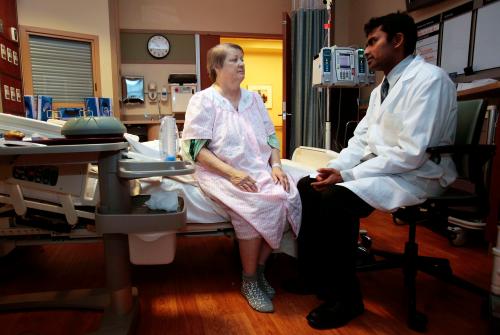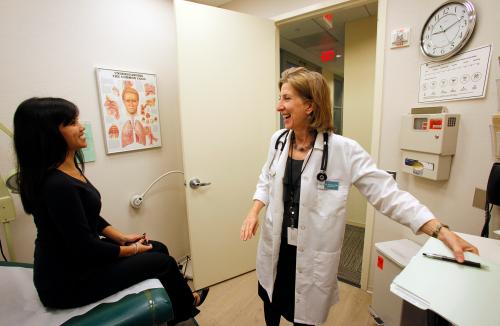This post originally appeared on the Health Affairs Blog.
In the heat of political gridlock when it seemed impossible for Congress to pass any laws, the Medicare and CHIP Reauthorization Act, commonly known as MACRA, was passed with overwhelming bipartisan support. MACRA, which was signed into law in April 2015, replaces the older fee-for-service payment models with a quality payment program which rewards value rather than volume. It may be the second most important law to reform the United States’ health care system after the Social Security Amendments which created Medicare and Medicaid in 1965.
According to the MACRA rules proposed by Department of Health and Human Services (HHS), by January 2017, clinicians should choose to be a part of either an alternative payment model (APM) or a Merit-based Incentive Payment System (MIPS). Most clinicians would automatically qualify to be a part of MIPS which first assigns a “composite performance score” for each clinician based on four domains of quality, advancing care information, clinical practice improvement activities, and resource use as shown in Figure 1.
To calculate this score, only the resource use element is directly measured by the Centers for Medicare and Medicaid Services (CMS) based on submitted Medicare claims, and the other three elements are self-reported by clinicians. In 2019, clinicians who outperform their peers will receive a 4 percent bonus while those who don’t, will face a 4 percent penalty. The bonuses and penalties rise to 5 percent, 7 percent, and 9 percent in the subsequent three years. While HHS had the best intentions in creating MIPS, the proposed rules are so abundant with flaws and weaknesses that it is very difficult to imagine the program could ever be successfully implemented.
Figure 1: Structure Of Composite Performance Score

An Open Invitation To Game The System
A scoring system which is heavily based on self-reporting is not a new idea. A very similar format has already been implemented by HHS to compare nursing homes in a five-star rating system based on two self-reported measures of quality and staffing and one measure of on-site health inspections conducted by HHS auditors. As reported by The New York Times, a rating system largely based on self-reported measures is easily gamed. Cases have been reported in which patients’ personal experiences differ significantly from the star rating. Some five-star nursing homes have been sued for substandard care, even causing death of patient due to improper use of medical treatment.
Along with my colleagues, I have conducted empirical studies which confirm The New York Times’anecdotal evidence, showing that about 12 percent of nursing homes highly inflate their self-reported measures as a strategy to increase their overall star rating. Note that such manipulations take place even without powerful, direct financial incentives. Compared to nursing homes, clinicians will have significantly stronger financial incentives to exaggerate their self-reported measures, rendering the system ineffective.
While the majority of clinicians are honest, it only takes a small minority to game the system and make it ineffective for others. The fact that there is no clear auditing and punishment policy to deter rating manipulations could make matters worse. And if the bonuses and penalties assigned to clinicians in MIPS are not based on clinical merit, then the program will fail to increase true medical quality.
Rewarding reporting capabilities instead of medical excellence
MIPS requires clinicians to report at least 18 different measures to HHS, many of which require an Electronic Health Record (EHR) system and extensive data collection efforts. A recent study by a group of researchers at Weill Cornell Medical College shows that an average American physician annually spends 785 hours on quality reporting activities which costs the US health care system more than $15.4 billion per year.
Another study in Annals of Internal Medicine reports that “for every hour physicians provide direct clinical face time to patients, nearly two additional hours is spent on EHR and desk work within the clinic day.” To comply with MIPS reporting requirements, physicians will have to bear even higher costs. This leaves them with two choices: either become a part of a larger practice that can handle the overhead costs of the reporting requirements or stop seeing Medicare patients altogether. Declining numbers of small and solo-physician practices will ultimately give large medical practices even greater bargaining power than they currently have, allowing them to negotiate even higher prices for their services.
An unreliable quality score
The six measures for the quality domain are chosen by physicians from a wide variety of available measures depending on their specialty and preferences. For example, a family physician could choose six measures from the 38 available options.
This means that there will be 2,760,681 possible combinations of quality profiles reported by family physicians alone. Each of those possible profiles measures a different aspect of medical quality. This large variation makes it impossible to evaluate physicians and assign a reliable performance score to them. Scoring physicians of identical medical specialty based on different measures is akin to comparing students’ performance based on different types of questions and exams.
Inadequate feedback loops
As initially proposed, MIPS reporting period starts in January 2017 and lasts for one full year until December 2017, but the payments will be determined in January 2019, two years after the physicians started their reporting. HHS has proposed annual feedbacks at the middle of reporting periods, starting on July 2017. But that is not enough. Clinicians need much shorter feedback intervals to compare themselves with their peers. In a system which rewards or penalizes clinicians based on their position relative to others, it is necessary to have real-time feedback loops, especially if their current performance will affect their earnings two years later.
Despite its significant financial implications, nearly 50 percent of physicians are not familiar with MACRA according to a recent survey by Deloitte. Starting with that baseline, it is clear that physicians would not have enough time between now and January 1 to make an informed choice between participating in MIPS or an APM, especially when the risks and benefits of these programs are almost completely unknown to them. Physicians are forced to choose between two dramatically different paths and keep their fingers crossed for the next two years with very little information to judge if they made the right choice.
Undermining Patient Privacy
To ensure interoperability and prevent data blocking practices, Authorized Certification Bodies (ACB) designated by the Office of the National Coordinator (ONC) will conduct onsite surveillance on the EHR systems of the MIPS-eligible clinicians. The proposed rule indicates that a “health care provider is permitted to disclose protected health information (PHI) (without patient authorization and without a business associate agreement) to an ONC-ACB during the limited time and as necessary for the ONC-ACB to perform the required on-site surveillance of the certified EHR technology.”
I have built my career on advocating for interoperability, yet I believe that the proposed solution is extremely dangerous and inefficient. Some have even argued that the proposed rule undermines the fourth amendment. On-site surveillances are not only intrusive and expensive, but they also increase the potential of data breaches as more people will have access to health information. The conditions under which ONC-ACBs are permitted to conduct on-site surveillances of EHRs should be carefully defined and limited to absolutely necessary situations where there is no other way to investigate data blocking practices.
ONC can implement other solutions to ensure interoperability. For example, using referral data, ONC can identify the clinicians who refer patients to a particular provider and ask them if they have any difficulty in receiving medical data from that provider. Other solutions include using fictitious data, rather than real protected health information, to test the interoperability capabilities of the EHR software on site.
Pick Your Pace
On September 8, 2016 Andrew Slavitt, Acting Administrator of CMS, introduced two new options in addition to the MIPS and APM programs, to “allow physicians to pick their pace of participation for the first performance period.” These options will allow clinicians to submit only partial data or to participate for a partial period of time. Choosing either of these options will enable clinicians to avoid penalties while adapting to the changes. Assuming that many clinicians would take advantage of these option, the change effectively delays full MACRA implementation by one year. I believe such a delay is a good thing, offering officials a critical and urgent opportunity to adequately address the many shortcomings outlined above.










Commentary
New HHS rules undermine the most important health care law in fifty years
October 12, 2016